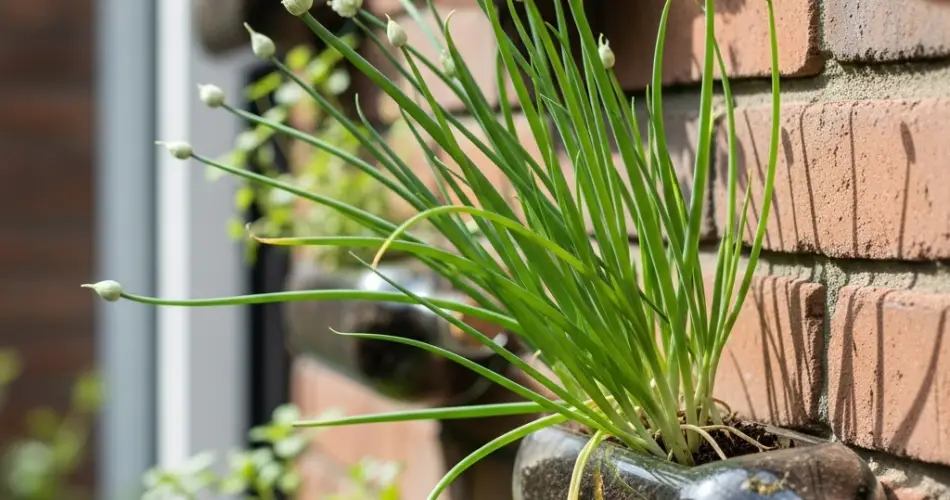If you’re short on garden space but want a steady supply of fresh scallions, a vertical garden made from recycled plastic bottles is an ideal solution. This DIY setup turns any sunny wall, fence, or balcony railing into a lush, productive green wall of flavorful scallions. Also known as green onions or spring onions, scallions grow well in small containers and are perfectly suited for vertical bottle planters.
This simple and sustainable project is low-cost, space-saving, and perfect for beginners. With a few tools, some empty bottles, and basic potting soil, you can grow your own scallions all year round—even in the city.
Why Grow Scallions on a Wall?
Scallions don’t need deep soil or a lot of room to thrive, making them excellent candidates for small-scale vertical gardening. Their shallow root systems and upright growth habit mean you can grow them in rows of containers attached to a wall or fence.
Benefits of a scallion wall garden include:
-
Saving horizontal space
-
Reusing plastic bottles that would otherwise go to waste
-
Easy harvesting and maintenance
-
Clean, organized planting in small areas
-
A continuous harvest by regrowing from kitchen scraps or new seeds
Materials Needed
To build your DIY scallion wall, gather the following:
-
Several 1.5L or 2L plastic bottles
-
A sharp utility knife or scissors
-
Potting soil with good drainage
-
Scallion seeds or rooted scallion stalks
-
Twine, wire, or zip ties for hanging
-
A drill, nail, or heated skewer for making holes
-
A wall, fence, or wooden board as your vertical base
Optional: wood screws and hooks if mounting directly to a wooden panel or railing.
Preparing the Bottles
-
Clean and Dry Bottles
Wash each bottle thoroughly and remove labels. -
Cut Out Planting Windows
Use scissors or a knife to cut a rectangular window along the side of the bottle—large enough to fill with soil and insert scallion stems. Leave the neck and base intact for stability. -
Add Drainage Holes
Use a skewer or drill to poke 4–6 small holes in the bottom of each bottle for water drainage. -
Create Hanging Points
Near the top and bottom edges of each bottle, poke small holes for stringing or attaching to your wall structure.
Setting Up Your Wall Garden
Choose a sunny spot that receives 4–6 hours of sunlight a day. This could be a garden fence, an exterior wall, or even a window grille.
-
Mount the Bottles:
Thread string, wire, or zip ties through the prepared holes and secure each bottle horizontally to the wall. Arrange them in rows or staggered columns to optimize light exposure and watering. -
Fill with Soil:
Pour quality potting soil into each bottle, pressing gently to eliminate air pockets. Leave about 2 cm of space at the top.
Planting Your Scallions
You can grow scallions from either seeds or leftover stalks from the kitchen:
-
From Seeds:
Sow 5–6 seeds per bottle about 1–2 cm deep. Water gently and keep the soil moist until seedlings appear in 7–10 days. -
From Kitchen Scraps:
Use the white root ends of store-bought scallions. Trim about 5 cm above the roots and plant them root-end down into the soil. Water lightly.
Scallions grow quickly, and regrowth from scraps is particularly rewarding—you’ll often see green shoots within days.
Caring for Your Scallion Wall
-
Watering:
Water gently when the top inch of soil feels dry. In warm climates, check daily. Bottles drain quickly, so don’t let the soil dry out completely. -
Feeding:
Apply a light organic fertilizer or compost tea every 2–3 weeks to promote lush, green growth. -
Trimming:
Once the greens are about 15–20 cm tall, harvest by snipping the leaves 2–3 cm above the base. The plant will regrow several times from the same root base.
Continuous Harvest Tips
-
Successive Planting:
Stagger your planting every 1–2 weeks in different bottles to ensure a constant supply of scallions. -
Rotate Bottles:
If one bottle becomes exhausted or overcrowded, replace the soil and replant with new scallion bases or seeds. -
Watch for Pests:
Scallions are usually pest-resistant, but aphids or fungus gnats can sometimes appear. A light neem oil spray or insecticidal soap can help control issues.
Final Thoughts
A scallion wall garden made from plastic bottles is not only a clever use of vertical space—it’s also an environmentally friendly way to reuse plastic and grow your own fresh food. Whether you’re gardening on a balcony, a courtyard fence, or an apartment wall, this project adds greenery, flavor, and function to your living space.
With just a little care and minimal materials, you’ll enjoy an ongoing harvest of crisp scallions—perfect for garnishing, stir-frying, and brightening up your meals.



